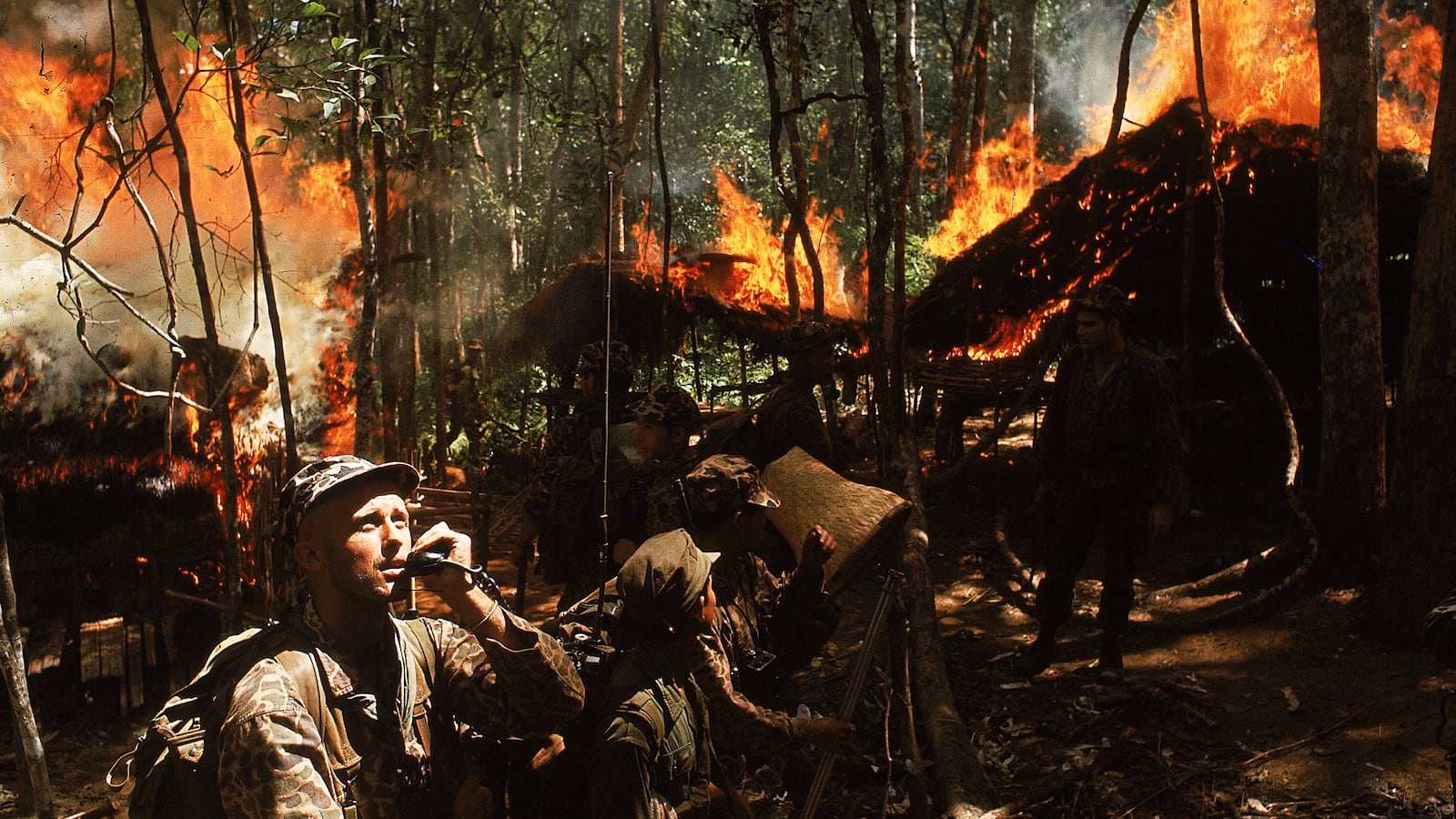One day, in the far distant future, when our hair is gray and our minds are gone, perhaps, maybe, the country can move on from the Vietnam War. As of now, the prospects of such a day dawning don’t look good.
The first American killed in the war died in 1956, and we haven’t had an election since in which the war wasn’t in some ways central to the debate.
This includes elections long after the last American left. Consider John Kerry’s behavior on a Swift Boat in the Mekong Delta to George Bush’s stint in the Texas Air National Guard to Bill Clinton’s letter to the draft board. The war has kept its hold on the culture too, from Apocalypse Now to Platoon to Fog of War.
Just when one might think the war may have lost its hold, that the country may at last find new eras to obsess over, The Sympathizer, a novel by a Vietnamese-American about the aftermath of the war won the Pulitzer Prize in 2016. This month PBS drops a 10-part documentary on the conflict, while Donald Trump forces us to debate his bone spurs and whether or not sleeping around in the 1980s should be the equivalent of serving in the conflict.
And so the war is caught, both a moment in increasingly distant history and a shadow that the nation has been unable to crawl out from under.
It is into this breach that new exhibit opens this week at the New York Historical Society, called simply The Vietnam War: 1945-1975. It is the rare Historical Society show to explore the recent past.
“The consequences and the ramifications of the war just continue,” said Marci Reaven, the curator behind the show. “The war raised issues that are at the core of U.S. society, about what’s meant by patriotism and duty and loyalty and citizenship and democracy and morality and our role in the world.”
The exhibit begins before the war does. There are illustrations from Collier’s magazine of New York City engulfed in the fire and flame of a nuclear bomb, a reminder that as misguided as they may have turned out to be, the fears of a nuclear armed enemy spreading its influence into Asia were real.
The exhibit cleverly alternates between the political climate during the war and the societal climate the conflict created; from presidential directives–like Lyndon Johnson’s televised announcement that the U.S. was going to escalate troop levels–to the various forms of resistance to the war by the young men called to fight in it.
The exhibit gives short shrift to some of the ways in which the lions of the Greatest Generation were unable to put aside a World War II mindset that couldn’t help but compare the spread of Communism in southeast Asia with the spread of Nazism across Europe.
The same mindset saw the war as engendering the kind of mass mobilization and public spiritedness that the nation saw in the 1940s.
The exhibit presents the decision to go to war as a series of cynical political moves by politicians who knew better.
Both President Kennedy and President Johnson are shown to have deep reservations about the country’s ability to win a land war so far overseas and in particularly in their South Vietnamese allies, but didn’t want to suffer from the political fallout of failure.
Outside of the political class, the show suggests, there was little doubt that the war was a mistake.
The draft was largely a class phenomenon, and the show quotes the writer James Fallows’ recollections of going to the Boston Navy Yard draft board with his fellow Harvard students, “throwing its urine and deliberately failing its color blindness tests,” while “the white proles of Boston” pull up behind them “like so many cattle off to slaughter.”
“There was something close to the surface that none of us wanted to mention,” he writes. “We knew now who would be killed.”
Thirty years of a war, one that has been litigated to the point of exhaustion, is too much for one small show.
The focus here is largely on the story behind some of the familiar images from the war, like the My Lai massacre and the election of 1968, but some of its objects are more anachronistic than illuminating, like the New York City Board of Elections voting booth from that year or a Vietnamese bicycle that may or may not have been used to ferry supplies along the Ho Chi Minh trail.
Save for an original War Front illustrated mural by the artist Matt Huynh that comes with a digital explainer accompaniment, the Vietnamese side is given short shrift.
There are other pieces included that shock and delight. Piled high and locked behind glass are the full stack of the Pentagon Papers, which helped sour the public on the war.
Not only did Daniel Ellsberg’s alleged treachery pave the way for a new era of press freedom, the wall text explains, but they helped end the tenure of President Nixon, as the small band of burglars were used to break into Ellsberg’s psychiatrist’s office to look for dirt on the leaker were later put to use to break into the Democratic National Committee’s headquarters at the Watergate.
Also among the surprising finds are a series of videos from something called “The Committee to Unsell The War,” a collaboration between Madison Avenue and some campus protesters that feature, among others, John Kerry as a spokesperson.
The small, personal artifacts of the soldiers who served, and the tributes to those who didn’t come back, do more to bring the war to life than any of the TV broadcasts or official communiques.
There is a collection of Zippo lighters with scribbled subversive messages: “The army is like a rubber,” reads one. “It gives you a feeling of security while you are getting fucked.” Adds another, “Give me your hearts and minds or I will wreck your fucking huts.”
There is graffiti that soldiers scratched onto their berths as they sailed across the Pacific, and notes and mementos left at the Vietnam Memorial, including a baseball mitt with a long life update to the writer’s father attached, and, wordlessly, a pale blue baby sweater.
There is also a documentary shot in 1967 that details one Virginia family’s struggle to overcome the death of their son after only a few months overseas. In his letters home soldier Tony Jones had defended the war effort, and asked for oil for his rifle and bug spray.
The curators placed a small white wooden box of Kleenex on the bench next to the video. I can report that on the day I attended The Vietnam War: 1945-1975 it did not go unused.
The Vietnam War: 1945-1975 is at the New York Historical Society until April 22, 2018. Details here.






